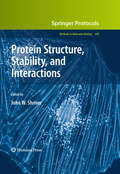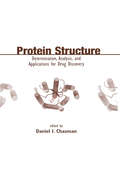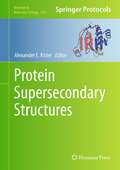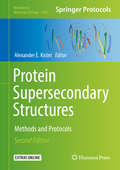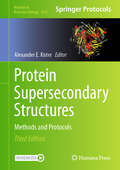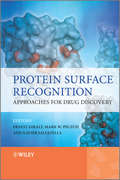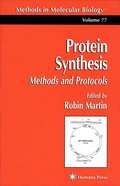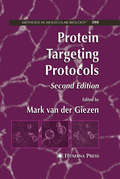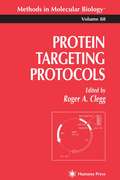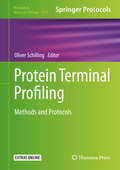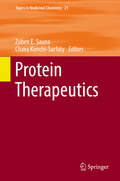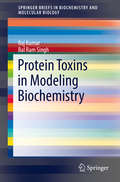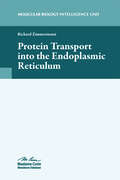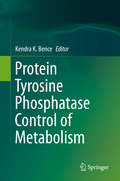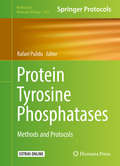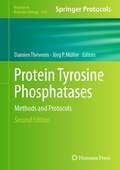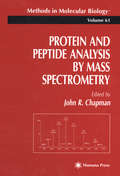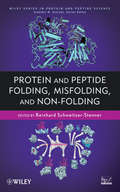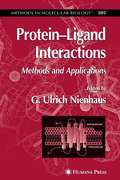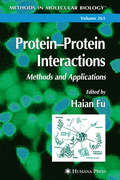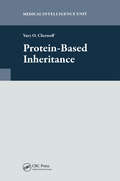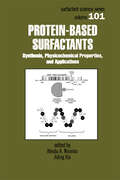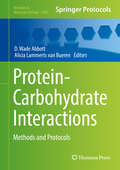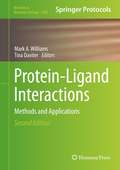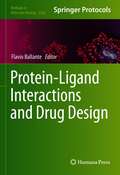- Table View
- List View
Protein Structure, Stability, and Interactions
by John W. ShriverIn the areas of biochemistry and cell biology, characterizations of stability and molecular interactions call for a quantitative approach with a level of precision that matches the fine tuning of these interactions in a living cell. Supporting and up-dating previous Methods in Molecular BiologyTM volumes, Protein Structure, Stability, and Interactions approaches its subject with a focus on theory and practical applications for both established methods as well as exciting new procedures. The volume presents an overview of many techniques currently used to study protein stability and interactions, including scanning and titration calorimetry, spectroscopic methods, high field NMR, and analytical ultracentrifugation. As a volume of the highly successful Methods in Molecular BiologyTM series, this work provides the kind of detailed description and implementation advice that is crucial for getting optimal results. Cutting-edge and easy to reference, Protein Structure, Stability, and Interactions is an ideal guide for all scientists interested in biomolecular interactions.
Protein Structure: Determination, Analysis, and Applications for Drug Discovery
by Daniel I. ChasmanThis text offers in-depth perspectives on every aspect of protein structure identification, assessment, characterization, and utilization, for a clear understanding of the diversity of protein shapes, variations in protein function, and structure-based drug design. The authors cover numerous high-throughput technologies as well as computational met
Protein Supersecondary Structures
by Alexander E. KisterSuper secondary structure(SSS) helps to understand the relationship between primary and tertiary structure of proteins. In Protein Supersecondary Structure: Methods and Protocols expert researchers in the field detail the usefulness of the study of super secondary structure in different areas of protein research. This is done through four main studies SSS representation, SSS prediction, SSS and protein folding, and other application of SSS concept to protein biology. Written in the highly successful Methods in Molecular BiologyTM series format, chapters include introductions to their respective topics, lists of the necessary materials and reagents, step-by-step, readily reproducible laboratory protocols, and key tips on troubleshooting and avoiding known pitfalls. Authoritative and practical, Protein Supersecondary Structure: Methods and Protocols highlight some of the major advances in the many fast-growing areas of supersecondary structure research.
Protein Supersecondary Structures (Methods In Molecular Biology #932)
by Alexander E. KisterThis second edition volume expands on the previous edition with an update on the latest developments in the field and new techniques used to study secondary and supersecondary structures (SSS) in proteins. Chapters in this book discuss topics such as sequence and structural features of different SSS elements; software used for the automatic annotation of secondary structure elements in proteins; the new developments in secondary and SSS prediction and the modern approaches for energy landscape calculation; protein misfolding and amyloid structural formation; analysis of ‘transformer proteins’; discovery of the structure of the hydrophobic nucleus; and discussions of the main principles of protein structures formation. The contributing authors of the volume are the eminent experts in the field of protein research and bioinformatics. Written in the highly successful Methods in Molecular Biology series format, chapters include introductions to their respective topics, lists of the necessary materials and reagents, step-by-step, readily reproducible laboratory protocols, and tips on troubleshooting and avoiding known pitfalls. <P><P> Cutting-edge and authoritative, Protein Supersecondary Structures: Methods and Protocols, Second Edition is a valuable resource for researchers who are interested in learning more about the relationship between amino acids sequences and protein structures, the evolution of proteins and the dynamics of protein formation.
Protein Supersecondary Structures: Methods and Protocols (Methods in Molecular Biology #2870)
by Alexander E. KisterThis new edition delves into the latest developments in the field and new techniques used to study secondary and supersecondary structures (SSS) in proteins. Beyond the tremendous advances in the field from the AI-based AlphaFold algorithm, researchers continue to untangle how specific structures and protein folds come to be, and these chapters contain numerous techniques to further pursue this study. Written for the highly successful Methods in Molecular Biology series, chapters contain the kind of detailed implementation advice needed to ensure effective results in the lab. Authoritative and practical, Protein Supersecondary Structures: Methods and Protocols, Third Edition serves as a valuable resource for researchers exploring the relationship between amino acids sequences and protein structures, the evolution of proteins, and the dynamics of protein formation.
Protein Surface Recognition
by Mark Peczuh Ernest Giralt Xavier SalvatellaA new perspective on the design of molecular therapeutics is emerging. This new strategy emphasizes the rational complementation of functionality along extended patches of a protein surface with the aim of inhibiting protein/protein interactions. The successful development of compounds able to inhibit these interactions offers a unique chance to selectively intervene in a large number of key cellular processes related to human disease.Protein Surface Recognition presents a detailed treatment of this strategy, with topics including:an extended survey of protein-protein interactions that are key players in human disease and biology and the potential for therapeutics derived from this new perspectivethe fundamental physical issues that surround protein-protein interactions that must be considered when designing ligands for protein surfacesexamples of protein surface-small molecule interactions, including treatments of protein-natural product interactions, protein-interface peptides, and rational approaches to protein surface recognition from model to biological systemsa survey of techniques that will be integral to the discovery of new small molecule protein surface binders, from high throughput synthesis and screening techniques to in silico and in vitro methods for the discovery of novel protein ligands.Protein Surface Recognition provides an intellectual "tool-kit" for investigators in medicinal and bioorganic chemistry looking to exploit this emerging paradigm in drug discovery.
Protein Synthesis
by Robin MartinThis book presents a collection of molecular biological methods specific to protein synthesis. Chapters open with a discussion of basic background information and strategy which is then complemented by comprehensive methodological details. The book is divided into seven significant areas that cover all of the research techniques required by both experienced researchers and newcomers to the field of protein synthesis, and will prove to be an invaluable reference source on the benchtop of many protein laboratories.
Protein Targeting Protocols
by Mark Van GiezenIn this updated volume, experts from around the world provide the latest protocols for isolating different organelles and the localization of particular proteins using a variety of methods such as light, confocal, and electron microscopy. Emphasis is placed on protein targeting of cellular compartments in both prokaryotic and eukaryotic systems. The book includes targeting protocols from different systems.
Protein Targeting Protocols
by Roger A. CleggMaster experimentalists describe, largely from the perspective of intracellular signaling, their best methods for detecting and analyzing the proteins and protein motifs involved in targeting interactions. The techniques range from basic methods that reveal the existence of targeting interactions and characterize physicochemical properties to those for analyzing the more structurally elaborate systems involved in the movement of molecules between cellular compartments, with examples taken from nuclear transport, clathrin-coated vesicle traffic, and secretory sorting. The themes of targeting domains, particularly the SH-2, SH-3, and PH domains, and the principal targeting of lipid modifications-myristoylation, reversible palmitoylation, prenylation-are fully explored. This book will serve well as a firm methodological foundation for laboratories newly entering this field and as an indispensable reference work for those already well-established in it.
Protein Terminal Profiling
by Oliver SchillingThis volume presents detailed protocols for novel strategies and approaches to improve functional understanding of protein N- and C-terminal biology. Protein Terminal Profiling: Methods and Protocols addresses topics such as protease specificity profiling, N-terminal acetylation, assays to probe protease activity in cellular systems, protein N- and C-termini on a proteome-wide scale, and biochemical approaches to explain and examine extracellular protease activities. Written in the highly successful Methods in Molecular Biology series format, chapters include introductions to their respective topics, lists of the necessary materials and reagents, step-by-step, readily reproducible laboratory protocols, and tips on troubleshooting and avoiding known pitfalls. Cutting-edge and thorough, Protein Terminal Profiling: Methods and Protocols is a valuable resource for researchers that focus on biochemistry and cell biology, and those who share a broad interest in protein functionality and protein modifications.
Protein Therapeutics
by Zuben E. Sauna Chava Kimchi-SarfatyMedicinal chemistry is both science and art. The science of medicinal chemistry offers mankind one of its best hopes for improving the quality of life. The art of medicinal chemistry continues to challenge its practitioners with the need for both intuition and experience to discover new drugs. Hence sharing the experience of drug research is uniquely beneficial to the field of medicinal chemistry. Drug research requires interdisciplinary team-work at the interface between chemistry, biology and medicine. Therefore, the topic-related series Topics in Medicinal Chemistry covers all relevant aspects of drug research, e. g. pathobiochemistry of diseases, identification and validation of (emerging) drug targets, structural biology, drugability of targets, drug design approaches, chemogenomics, synthetic chemistry including combinatorial methods, bioorganic chemistry, natural compounds, high-throughput screening, pharmacological in vitro and in vivo investigations, drug-receptor interactions on the molecular level, structure-activity relationships, drug absorption, distribution, metabolism, elimination, toxicology and pharmacogenomics. In general, special volumes are edited by well known guest editors
Protein Toxins in Modeling Biochemistry
by Raj Kumar Bal Ram SinghThis succinct volume addresses the production of inactive, potentially toxic proteins in the absence of correct protein folding and the resultant neurodegenerative diseases. Other topics include intrinsic disorder in protein structure and function and the effects of molten globules on protein toxicity. This concise and yet thorough text also discusses using toxin structure as a model for studying structural and functional aspects of protein chemistry. Protein Toxins in Modeling Biochemistry, a SpringerBrief, is essential reading for advanced researchers, scientists and advanced graduate students interested in protein chemistry and related areas of biochemistry and molecular science.
Protein Transport into the Endoplasmic Reticulum
by Richard ZimmermannProtein transport into the endoplasmic reticulum (ER) is just one aspect of the general cell biology topic of intracellular protein sorting. This larger picture also includes protein transport into other organelles of the eukaryotic cell (chloroplasts, mitochondria, nucleus, peroxisomes), protein export from bacteria, vesicular transport that deliv
Protein Tyrosine Phosphatase Control of Metabolism
by Kendra K. BenceAlthough phosphorylation of proteins on tyrosine is relatively rare compared to phosphorylation on serine or threonine residues, the past two decades of research into PTP function have led to a great appreciation of the critical role PTPs have in regulating basic cellular processes. Among these important roles is the regulation of cellular signaling pathways related to metabolism. This volume contains chapters which highlight many aspects of PTP function in the context of metabolism. Given the growing obesity and diabetes epidemics in the United States and throughout the world, the desire to identify possible therapeutic targets for treatment of these diseases is a high priority. In many ways, PTPs may be attractive drug targets since they are amenable to targeting with small molecules; however many challenges abound in making PTP inhibitors.
Protein Tyrosine Phosphatases
by Rafael PulidoThis book provides coverage, methodology, and laboratory protocols on the more essential aspects of protein tyrosine phosphatase (PTP) function and regulation, including the use of standardized in vitro functional assays, suitable cell systems, and animal and microorganism models. Chapters covering state-of-the-art technical approaches suitable to decipher the physiologic roles of PTPs, and their involvement in tissue-specific functions, are also included, which will be of utility for both newcomers and experienced researchers in the field of tyrosine- and phosphoinositide- phosphorylation/dephosphorylation. Written in the highly successful Methods in Molecular Biology series format, chapters include introductions to their respective topics, lists of the necessary materials and reagents, step-by-step, readily reproducible laboratory protocols, and tips on troubleshooting and avoiding known pitfalls. Authoritative and practical, Protein Tyrosine Phosphatases: Methods and Protocols aims to aid researchers in better defining the common and individual features of the PTP family members and translating this knowledge into PTP-based therapy for human disease.
Protein Tyrosine Phosphatases: Methods and Protocols (Methods in Molecular Biology #2743)
by Jörg P. Müller Damien ThéveninThis second edition volume expands on the previous edition with discussions on the latest advancements in protein tyrosine phosphatases (PTP) research used to investigate these essential enzymes and new inhibitors. The new techniques covered in the chapters of this book include studying enzymes in vitro, in cells, and in animal models through proteomics, genomics, and structural biology. Furthermore, new advances in pharmacology and drug design have contributed to the developing novel therapeutics that target PTPs. Written in the highly successful Methods in Molecular Biology series format, chapters include introductions to their respective topics, lists of the necessary materials and reagents, step-by-step, readily reproducible laboratory protocols, and tips on troubleshooting and avoiding known pitfalls.Cutting-edge and comprehensive, Protein Tyrosine Phosphatases: Methods and Protocols, Second Edition is a valuable resource for both experienced and novel researchers in this field, and will lead to discoveries and accelerated progress in the field of PTP, signal transduction, and drug development.
Protein and Peptide Analysis by Mass Spectrometry
by John R. ChapmanLeading practitioners authoritatively describe the newest and most effective spectrometric techniques for the analysis of proteins and peptides. The areas covered range from the elucidation of primary and secondary protein structure and the rapid identification of proteins using database techniques to methods for sequencing, as well as methods for the quantitative determination of peptides. Other chapters provide detailed information on the analysis of glycoproteins and glycopeptides and on the use of mass spectrometry to probe the interactions of proteins, both covalent and noncovalent.
Protein and Peptide Folding, Misfolding, and Non-Folding
by Vladimir Uversky Reinhard Schweitzer-StennerSheds new light on intrinsically disordered proteins and peptides, including their role in neurodegenerative diseases With the discovery of intrinsically disordered proteins and peptides (IDPs), researchers realized that proteins do not necessarily adopt a well defined secondary and tertiary structure in order to perform biological functions. In fact, IDPs play biologically relevant roles, acting as inhibitors, scavengers, and even facilitating DNA/RNA-protein interactions. Due to their propensity for self-aggregation and fibril formation, some IDPs are involved in neurodegenerative diseases such as Parkinson's and Alzheimer's. With contributions from leading researchers, this text reviews the most recent studies, encapsulating our understanding of IDPs. The authors explain how the growing body of IDP research is building our knowledge of the folding process, the binding of ligands to receptor molecules, and peptide self-aggregation. Readers will discover a variety of experimental, theoretical, and computational approaches used to better understand the properties and function of IDPs. Moreover, they'll discover the role of IDPs in human disease and as drug targets. Protein and Peptide Folding, Misfolding, and Non-Folding begins with an introduction that explains why research on IDPs has significantly expanded in the past few years. Next, the book is divided into three sections: Conformational Analysis of Unfolded States Disordered Peptides and Molecular Recognition Aggregation of Disordered Peptides Throughout the book, detailed figures help readers understand the structure, properties, and function of IDPs. References at the end of each chapter serve as a gateway to the growing body of literature in the field. With the publication of Protein and Peptide Folding, Misfolding, and Non-Folding, researchers now have a single place to discover IDPs, their diverse biological functions, and the many disciplines that have contributed to our evolving understanding of them.
Protein'Ligand Interactions: Methods and Applications (Methods in Molecular Biology #305)
by G. Ulrich NienhausA readily reproducible collection of established and emerging techniques for studying the interaction between proteins and ligands, including biochemical/bulk techniques, structure analysis, spectroscopy, single-molecule studies, and theoretical/computational tools. Among the highlights are surface plasmon resonance (SPR) and reflectometric biosensor approaches, high-throughput screening with confocal optics microscopy, single molecule fluorescence and fluorescence correlation spectroscopy (FCS), atomic force microscopy (AFM), crystallography of reaction intermediates, and time-resolved x-ray crystallography. The protocols follow the successful Methods in Molecular BiologyTM series format, each offering step-by-step laboratory instructions, an introduction outlining the principle behind the technique, lists of the necessary equipment and reagents, and tips on troubleshooting and avoiding known pitfalls.
Protein'Protein Interactions
by Haian FuA collection of highly successful biochemical, biophysical, genetic, and computational techniques for studying protein-protein interactions. These readily reproducible methods demonstrate how to identify protein interaction partners, qualitatively or quantitatively measure protein-protein interactions in vitro or in vivo, monitor protein-protein interactions as they occur in living cells, and determine interaction interfaces. The techniques described utilize a variety of cutting-edge technologies, including surface plasmon resonance (SRP), fluorescence resonance energy transfer (FRET), fluorescence polarization (FP), isothermal titration calorimetry (ITC), circular dichroism (CD), protein fragment complementation assays (PCA), various two-hybrid systems, and proteomics and bioinformatics-based approaches, such as the Scansite program for computational analysis. These powerful tools are essential for deciphering how proteins interact with each other to form biological networks, as well as for unraveling protein-protein interactions in disease to find novel therapeutic targets.
Protein-Based Inheritance
by Dr. Yury ChernoffThis book covers a topic that has been neglected for years and has returned to the spotlight only recently. Until the genetic role of DNA was firmly established, many researchers suspected that proteins, rather than nucleic acids, could be carriers of heritable information. However, these models were completely forgotten with the triumphal march of the double helix and the development of a central dogma postulating that information flow occurs strictly from DNA, through RNA, to protein, making it seemingly impossible for the proteins to possess a coding potential. Proteins were downgraded to the role of simple perpetuators and executors of DNA orders. Taken together, data included in this book prove beyond a reasonable doubt that proteins and multiprotein complexes are able to control heritable traits, and that, at least in some examples, this control occurs in a template-like fashion, so that new structures strictly reproduce patterns of pre-existing structures that were not specifically coded in DNA. Thus, protein-based inheritance has left the area of speculation and has emerged as a new topic amenable to high-quality experimental analysis.
Protein-Based Surfactants: Synthesis: Physicochemical Properties, and Applications
by Jiding Xia"Describes preparation techniques of protein-based surfactants (PBS) in the laboratory by a variety of chemical and enzymatic means, production by using different types of amino acids, and marketplace applications of PBS in medical and personal care products, detergents, cosmetics, antimicrobial agents, and foods."
Protein-Carbohydrate Interactions
by D. Wade Abbott Alicia Lammerts van BuerenThis volume is a wide-ranging tool for studying protein-carbohydrate interactions that extend from traditional biochemical methods to state-of-the-art techniques. This book focuses on four different research themes: Part I describes methods for screening and quantifying CAZyme activity; Part II contains methods for investigating the interactions between proteins and carbohydrate ligands; Part III discusses methods for the visualization of carbohydrates and protein-carbohydrate complexes; and Part IV focuses on structural and "omic" approaches for studying systems of CAZymes. Written in the highly successful Methods in Molecular Biology series format, chapters include introductions to their respective topics, lists of the necessary materials and reagents, step-by-step, readily reproducible laboratory protocols, and tips on troubleshooting and avoiding known pitfalls. Cutting-edge and thorough, Protein-Carbohydrate Interactions: Methods and Protocols is a valuable resource to the glycomics research community. In this continuously advancing field, the methods in this book highlight the biology of glycomics, thus driving biotechnological innovation and solutions for human health and sustainable resources within the emerging green community.
Protein-Ligand Interactions
by Mark A. Williams Tina DaviterProteins are the cell's workers, their messengers and overseers. In these roles, proteins specifically bind small molecules, nucleic acid and other protein partners. Cellular systems are closely regulated and biologically significant changes in populations of particular protein complexes correspond to very small variations of their thermodynamics or kinetics of reaction. Interfering with the interactions of proteins is the dominant strategy in the development of new pharmaceuticals. Protein Ligand Interactions: Methods and Applications, Second Edition provides a complete introduction to common and emerging procedures for characterizing the interactions of individual proteins. From the initial discovery of natural substrates or potential drug leads, to the detailed quantitative understanding of the mechanism of interaction, all stages of the research process are covered with a focus on those techniques that are, or are anticipated to become, widely accessible and performable with mainstream commercial instrumentation. Written in the highly successful Methods in Molecular Biology series format, chapters contain introductions to their respective topics, lists of the necessary materials and reagents, step-by-step, readily reproducible laboratory protocols, and notes on troubleshooting and avoiding known pitfalls. Authoritative and accessible, Bioinformatics for Omics Data: Methods and Protocols serves as an ideal guide for researchers new to the field of biophysical characterization of protein interactions - whether they are beginning graduate students or experts in allied areas of molecular cell biology, microbiology, pharmacology, medicinal chemistry or structural biology.
Protein-Ligand Interactions and Drug Design (Methods in Molecular Biology #2266)
by Flavio BallanteThis detailed book collects modern and established computer-based methods aimed at addressing the drug discovery challenge from disparate perspectives by exploiting information on ligand-protein recognition. Beginning with methods that allow for the exploration of specific areas of chemical space and the designing of virtual libraries, the volume continues with sections on methods based on docking, quantitative models, and molecular dynamics simulations, which are employed for ligand discovery or development, as well as methods exploiting an ensemble of protein structures for the identification of potential protein targets. Written for the highly successful Methods in Molecular Biology series, chapters include introductions to their respective topics, lists of the necessary materials, step-by-step, readily reproducible laboratory protocols, and tips on troubleshooting and avoiding known pitfalls. Authoritative and cutting-edge, Protein-Ligand Interactions and Drug Design provides detailed practical procedures of solid computer-aided drug design methodologies employed to rationalize and optimize protein-ligand interactions, for experienced researchers and novices alike.
